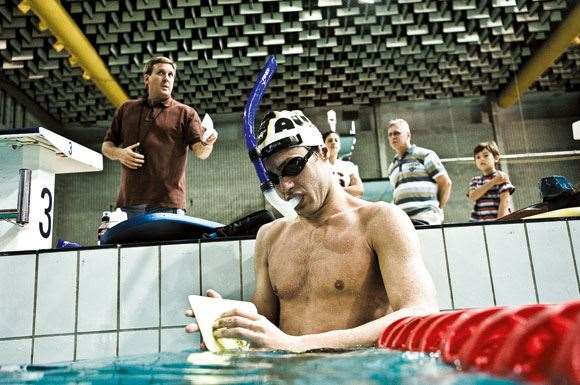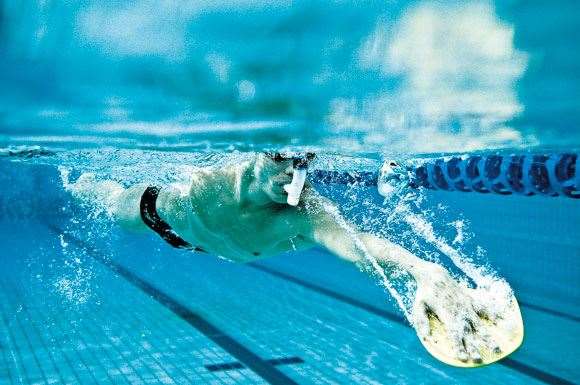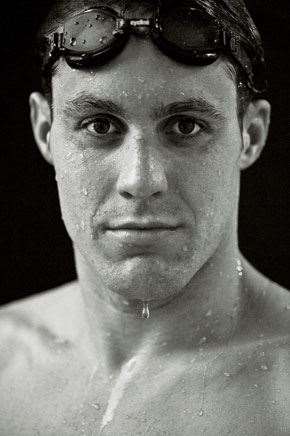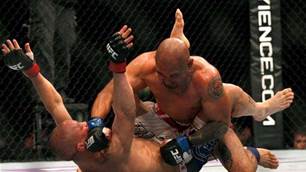The 25km open water swim is a distance event. And 24-year-old Brisbane phenomenon Brendan Capell just might make history repeat.
The 25km open water swim is a distance event. And 24-year-old Brisbane phenomenon Brendan Capell just might make history repeat.
 SwimTraining. images: Trent Mitchell
SwimTraining. images: Trent MitchellWith the swimming world’s attention focused squarely on Rome this month for the FINA World Championships, it’s a curious quirk that few will recognise the name of one of our best chances for gold in the premier men’s distance event. What’s that, you say? Surely with Hackett retired we’re looking decidedly thin in the 1500m ranks? No, not the 1500. That’s not a distance event. The 25km open water swim is a distance event. And 24-year-old Brisbane phenomenon Brendan Capell just might make history repeat.In 2004, at just 18, he won the World Championship, making him the first Australian male to win this event and the youngest ever internationally. In 2005, he backed up to win silver. Injuries have hampered his attempts in subsequent years: in 2006 he was diagnosed with six stress fractures in the left side of his back from overtraining. But under the watchful, expert eye of Michael Bohl at the St Peter’s Western Swim squad, he’s back to his best and primed for another tilt.
In 2008 he was back at the pointy end, finishing second behind Petar Stoychev (current English Channel record-holder and seven-times marathon swimming grand prix series champion) in the FINA Marathon Grand Prix series. He came fourth in the Olympic trial for the 10km and didn’t make it to Beijing last year – but 10k is just warming up for Capell. The longer the race, the better he goes. He races in Rome on July 25.Capell’s marathon feats also include his continued study for his law degree; he’s also studying a Masters of Applied Finance and is a youth ambassador for the Black-Dog Institute, which offers specialist expertise in depression and bipolar disorder. One busy, very impressive young man.
MARATHON EFFORT
“I did the trials back in February and qualified for the World Champs in July – that’ll be my two races this year. I don’t like to go any more than three or four a year, but in saying that, last year I actually swam the whole World Cup circuit – that was seven marathons in seven weekends. First one was just a 10k, then 36k Capri to Napoli, 19k in Serbia, 30k in Macedonia, and then lake swims in Canada which were 32 and 36k. I came second overall … I was pretty happy.”
LOADING UP
“A 25km race takes around five hours to complete. My normal preparation is ten pool sessions a week, usually of 7.5km, but Wednesday night (8km) and Saturday morning (10km) are my longer sessions. But things get mixed up. We might do two heart
rate sets, say Monday and Thursday afternoons, consisting of something like 30x100m, holding your heart rate at 170-180. And it might be a speed set on Tuesday night.
 Paddles lower heart rate and increase speed. Images: Trent Mitchell
Paddles lower heart rate and increase speed. Images: Trent Mitchell“Most of our mornings are the longer stuff where you do pull-buoy and [hand] paddle work. These sessions you’re often recovering from the main sets at night while still getting your aerobic fitness work in. Pull-buoys and paddles lower your heart rate and you can go a lot faster. You’re not working as hard, but you get the Ks in. Fins are used during warm-downs to break things up a bit. And then you’ve still got to condition your legs with a kickboard – that’s about a K per session. The last couple of years I’ve used the snorkel to take the pressure off my shoulders and neck a bit. I can put the snorkel on and do a 4k swim without even looking up. That breaks things up.
“But Wednesday and Saturday mornings are more race simulation stuff, whether it’s a 5km time trial or 15x500s, trying to come home hard at the end on short rest cycles … Different stuff like that.“On top of that I do two one-hour pilates sessions a week. My physio suggested them when I found I had six stress fractures in my back in 2006 from overtraining; he suggested pilates to maintain shoulder and back strength. I don’t do weights: when you’re doing 80-90km a week in the pool, weights tend to tear you down. For marathon swimming you’ve just got to keep lean and toned and pilates really works for me.“Our coach also takes us for dry land ab sessions four times a week before we get into the pool – that’s 30 minutes of sit-ups, abdominal work, crunches, working on our core strength. I think our coach got the idea for that from the diving team.”
BACK TO BASICS
“Stress fractures are pretty rare in swimming. For a while mine went undiagnosed and I was getting fairly frustrated; I just thought it was tightness. They started low in my back and worked their way up to the point where I couldn’t breathe and knew something was wrong. I actually changed physios: Ed Fitzgerald, the Wallabies’ physio, was straight onto it. He got me to go for a nuclear bone scan and I remember the radiologist asking me if I’d been kneed in the back.“I seem to naturally get fairly tight on the left side of my back doing all the work; my left hip also gets tight – I don’t know if that’s in the biomechanics of my stroke, or what. We open water swimmers tend to be a little bit rougher around the edges than the smooth techniques of the pool swimmers.”
 Brendan Capell Portrait. Images: Trent Mitchell
Brendan Capell Portrait. Images: Trent MitchellTAPERING OFF
“Marathon swimmers generally taper around a week out from an event. I drop my Ks and the intensity, but nothing compared to the pool guys. Our aerobic fitness is the most important part, and we have to keep that right up. So you can’t taper down too much or your body will get a shock when you push it in the race.”
VIEW FROM THE TOP
“Back in June we had three weeks’ training in Flagstaff, Arizona. There are six swimmers in my squad going to the Worlds this year, including Stephanie Rice and Kenrick Monk. ‘Bohley’ was good enough to take us over there; it’s 2300m above sea level, so it was my first time doing any kind of altitude training. It was very hard to do the sets up there, but I adapted pretty well, then came back and found I was flying in training. I know Michael Phelps was doing altitude work in Colorado at the same time, so our timing must have been good.”
RACE FACE
“People wonder how I can swim for five hours, but to be honest it goes pretty quick when you’re in the zone. You’ve always got to be concentrating – very aware of the other swimmers, always wondering if they’re going to take off, if you should let them go or go with them. You have to know their strengths and weaknesses. It’s a very tactical, strategic game. A lot of races come down to a flat-out sprint at the end – I lost the World Championships in 2005 by two seconds.
“It’s a lot like the peloton in the Tour de France – if you can drag behind the leaders as long as you can, that’s supposed to reduce your energy consumption by 30 per cent. You find a lot of the good guys just sit at the back of the pack for as long as they can. It’s about experience – some of the younger guys just want to take it out. It comes down to how you’re feeling: if you think you can break away, then you have to do it. Some swimmers like to get out the front and away from the mess in the middle, where you can get pretty fatigued if you’re fighting. If you’re just one or two swimmers off to the side of the leader – you’re getting the drag but getting clear water – that’s the optimum position.”
CHOWING DOWN
“I carbo load on Gatorade, Body Science Ecoade and Endura before I race, plus I use concentrated carbohydrate gels. During a race I feed every 15 minutes; if it’s a ten-lap, 2.5km course you normally have jetties positioned at each end and you take food there. You have a handler on the jetty who has a feeding stick – it’s a long extension pole with a cup on the end. You either drink from
it or eat something. I normally have a little bit of banana or apricot bar or lollies to keep the sugar up. Then you use caffeine towards the end of the race as a pick-me-up, like a Red Bull. “You grab the food out of the cup, do a stroke of backstroke to get it in your mouth, then turn over and keep on swimming while you chew.”
SUITING UP
“Because we’re governed by FINA, it’s the same rules as the pool guys, so no wetsuits are allowed. I wear the new Blue Seventy suit. I think it’s better than the Speedo suit for open water swimming. I definitely feel a bit more buoyant – I don’t mind whether they allow them or not, just so long as it’s a level playing field. It definitely keeps you warmer – last year I did two cold water races in Canada, and the temperature got down to 12 or 14 degrees. It almost acts as a semi-wetsuit. It definitely keeps you warmer and more buoyant.”
 No weights for Capell, just effective pilates sessions to avoid tear – and
No weights for Capell, just effective pilates sessions to avoid tear – andaid injury repair. image: Trent Mitchell
STRETCHING IT
“I use the SMRT physio device after every session because I get really tight through my left shoulder. It’s a self-treating physio system and really works for me; it’s got three adjustable components. I also get a massage once a fortnight, and try to see my physio every other week.”
R ’N’ R
“It’s very important to have a life out of the pool. Because I was never a super-talented age group swimmer, I always knew I would have to set myself up outside of the sport. I also realise my sport isn’t as glamorous as the pool and that I’m not going to make a living from it, so I’ve always been of the view that it’s important to get my education and qualifications and start developing a career for life after swimming. It keeps me busy: I might be studying all weekend and training all week – you definitely make sacrifices in your social and personal life, but at the same time you get to travel the world and have your fun when you’re over there and you’re achieving things. So, I think the benefits outweigh the negatives.“But it gets hard when you’re up to 1am studying and you know you have to be up at five. You try to sleep a bit during the day to recover for the afternoon session … It really becomes a management and balancing act.”
DOWN THE LINE
“The English Channel crossing is still the holy grail of marathon swimming. I’ve always wanted to do it, but it costs at least $10,000 by the time you add everything up. I always have good duels with the guy who’s got the Channel record – we kind of trade blows, where I win one and then he wins one … and he’s got the record.“There was almost a race organised for September this year. There was $30,000 for first prize, and I could do it for no cost. It was a good format and ready to go, but the French authorities said no for some reason. I’d love that record!”
MOTIVATION
“Traditionally, the older you are the better you get in our sport. Most of my main competitors are early 30s and I’m still early 20s; to win a World Championship at 20 is virtually unheard of. I plan to be around for a while yet. I get to swim in some of the best parts of the world: I’ve swum through the Suez Canal in Egypt and in the waters of Hawaii and the Mediterranean. You get to see the world and keep fit – it’s a good lifestyle. When you’ve got six other Australian reps at training every day, it definitely makes it a lot easier.”
– Graem Sims
Related Articles

The 15 most brutal MMA photos ever taken

The 15 most brutal MMA photos ever taken













